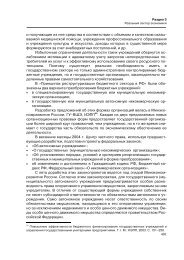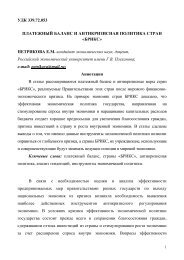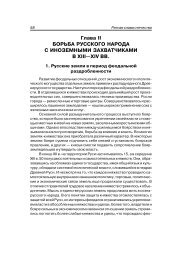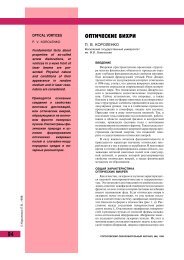Chapter 2: On <strong>the</strong> Pr<strong>in</strong>ciples <strong>and</strong> Parameters of <strong>Strategic</strong> <strong>Stability</strong>The core of <strong>the</strong> modern military <strong>and</strong> strategic balance is its most dangerous <strong>and</strong> destructivecomponent: nuclear forces <strong>and</strong> means, start<strong>in</strong>g with strategic assets. In this context, <strong>the</strong>re are veryclose connections among <strong>the</strong> two sides’ separate offensive <strong>and</strong> defensive forces <strong>and</strong> with<strong>in</strong> each of<strong>the</strong>ir military forces. At <strong>the</strong> same time, <strong>the</strong> stability of <strong>the</strong> balance, especially <strong>in</strong> <strong>the</strong> event of nuclearstalemate, is essentially <strong>in</strong>fluenced by <strong>the</strong>ir general-purpose forces <strong>and</strong> conventional arms.The concept of stability is implied to estimate how easy it is to startle <strong>and</strong> destabilize a system—<strong>in</strong>this <strong>in</strong>stance, <strong>the</strong> super-system of strategic nuclear <strong>in</strong>teraction—out of its current state. 27 Thisconcept logically implies an estimate of <strong>the</strong> risk of an outbreak of nuclear war, <strong>in</strong> view of <strong>the</strong>given correlation <strong>and</strong> structure of <strong>the</strong> parties’ military forces <strong>and</strong>, first <strong>and</strong> foremost, <strong>the</strong> strategicpotential of those forces. The ma<strong>in</strong> aspect of stability is <strong>the</strong> existence of a certa<strong>in</strong> potential barrierthat, if cleared as a result of some external disturbance, would cause <strong>the</strong> transition of <strong>the</strong> strategicmilitary super-system <strong>in</strong>to a qualitatively new state—from <strong>the</strong> typical <strong>in</strong>teractions of peacetime to<strong>the</strong> <strong>in</strong>teractions that are characteristic of <strong>the</strong> fundamentally different logic of military conflict, alogic that leads to a nuclear, strategic war.This potential barrier is formed by a group of political <strong>and</strong> military factors, where <strong>the</strong> pr<strong>in</strong>cipalfactor is a correlation between <strong>the</strong> follow<strong>in</strong>g elements:• The political <strong>and</strong> military goals of nuclear war of various scales <strong>and</strong> types;• The capabilities of each side to use force <strong>in</strong> <strong>the</strong> resolution of crisis situations, <strong>and</strong> <strong>the</strong> currentlyavailable material <strong>and</strong> technical resources available for <strong>the</strong> prosecution of such a war; <strong>and</strong>• The relevant consequences of us<strong>in</strong>g such force.The stability of <strong>the</strong> balance is determ<strong>in</strong>ed by <strong>the</strong> parameters, which are decisive factors <strong>in</strong> <strong>the</strong>evaluation of how easily one of <strong>the</strong> sides would disrupt <strong>the</strong> exist<strong>in</strong>g balance <strong>and</strong> atta<strong>in</strong> superiority,<strong>and</strong> how difficult it would be for <strong>the</strong> o<strong>the</strong>r side to take countermeasures to restore <strong>the</strong> balance byneutraliz<strong>in</strong>g <strong>the</strong>se steps.The concepts of balance or equilibrium, <strong>and</strong> stability formerly reflected one <strong>in</strong> <strong>the</strong> same conditionof strategic balance for each sides’ forces. In <strong>the</strong> first half of <strong>the</strong> 1970s, <strong>the</strong>se concepts began todiffer <strong>in</strong> <strong>the</strong>ir mean<strong>in</strong>g (<strong>the</strong> Soviet Union was several years beh<strong>in</strong>d <strong>the</strong> U.S. <strong>in</strong> <strong>the</strong> process of masstransition from s<strong>in</strong>gle-warhead missiles to MIRVs). 28 The term “equilibrium” more likely reflectsquantitative parameters of <strong>the</strong> exist<strong>in</strong>g nuclear super-system, while <strong>the</strong> concept of stability characterizesits quality. (Therefore, equilibrium, or balance, may be stable or unstable). The emergentdifference does not resolve itself <strong>in</strong>to <strong>the</strong> semantic nonidentity of <strong>the</strong> two concepts; ra<strong>the</strong>r, it isdeeply practical, s<strong>in</strong>ce it provides for <strong>the</strong> identification of <strong>the</strong> ma<strong>in</strong> problems that determ<strong>in</strong>e <strong>the</strong><strong>in</strong>crease or reduction of risk of nuclear conflicts, 29 <strong>in</strong>clud<strong>in</strong>g <strong>the</strong> risk of an outbreak of nuclearwar.Ma<strong>in</strong>tenance of military <strong>and</strong> strategic equilibrium with due regard for exist<strong>in</strong>g nuclear-missile armamentsdoes not stipulate ma<strong>in</strong>tenance of <strong>the</strong> exact symmetric equality of <strong>the</strong> two sides’ forces.To a certa<strong>in</strong> extent, <strong>the</strong> enormous destructive capacity of nuclear weapons equalizes <strong>the</strong>20<strong>Ensur<strong>in</strong>g</strong> <strong>Strategic</strong> <strong>Stability</strong> <strong>in</strong> <strong>the</strong> <strong>Past</strong> <strong>and</strong> <strong>Present</strong>: Theoretical <strong>and</strong> Applied Questions
differences between <strong>the</strong> parties’ arsenals, as well as <strong>the</strong> technical characteristics of certa<strong>in</strong> componentsof <strong>the</strong>ir strategic forces. It should always be borne <strong>in</strong> m<strong>in</strong>d that a nuclear explosion ischaracterized not only by an extremely high concentration of released energy <strong>in</strong> an extremelyshort time—fractions of a microsecond—but also by a variety of adverse factors: a major partof <strong>the</strong> energy is released <strong>in</strong> <strong>the</strong> form of <strong>the</strong> k<strong>in</strong>etic energy generated by <strong>the</strong> nuclear reaction <strong>and</strong>by neutron <strong>and</strong> gamma emissions. Apart from <strong>the</strong> blast wave <strong>and</strong> heat flash, <strong>the</strong> adverse factorsof nuclear weapons <strong>in</strong>clude penetrat<strong>in</strong>g radiation, radioactive contam<strong>in</strong>ation <strong>and</strong> electromagneticpulse (EMP). There are six types of nuclear explosions: <strong>the</strong> air burst, <strong>the</strong> high-altitude burst(above <strong>the</strong> troposphere boundary, which is higher than 10 km), <strong>the</strong> water-surface burst, <strong>the</strong>surface burst, <strong>the</strong> underwater burst <strong>and</strong> <strong>the</strong> subsurface burst. The latter may be with or withoutsoil displacement (<strong>the</strong> camouflet or conf<strong>in</strong>ed explosion). The ma<strong>in</strong> adverse factors of a subsurfacenuclear explosion <strong>in</strong>clude heavy seismic waves. A subsurface nuclear explosion with soil displacementis also accompanied by an air blast <strong>and</strong> severe radioactive contam<strong>in</strong>ation of <strong>the</strong> area. Oneof <strong>the</strong> characteristic features of <strong>the</strong>se explosions is <strong>the</strong> formation of a crater, which may vary <strong>in</strong>size depend<strong>in</strong>g on <strong>the</strong> yield, depth of explosion <strong>and</strong> type of soil. Subsurface bursts are designatedfor high-accuracy destruction of hardened embedded structures. With present-day conditions <strong>in</strong>m<strong>in</strong>d, a high-altitude burst is <strong>in</strong>terest<strong>in</strong>g first of all as a source of EMP <strong>and</strong> super-EMP, which primarilycause a blackout of <strong>the</strong> sensitive electronics of military <strong>and</strong> civil systems. 30 A surface bursttakes place on <strong>the</strong> ground surface or at when <strong>the</strong> fireball touches <strong>the</strong> ground surface; such explosionsare also designated for destruction of subsurface <strong>and</strong> hardened surface targets.The established military <strong>and</strong> strategic equilibrium has what Alex<strong>and</strong>er Vasiliev, <strong>the</strong> dist<strong>in</strong>guishedRussian expert on <strong>the</strong> problems of strategic stability <strong>and</strong> missile systems, once called a “safetymarg<strong>in</strong>.” (When describ<strong>in</strong>g this phenomenon, Major Gen. Vladimir Dvork<strong>in</strong> used <strong>the</strong> term “stabilitymarg<strong>in</strong>.”) The existence of such a marg<strong>in</strong>, <strong>and</strong> an accurate underst<strong>and</strong><strong>in</strong>g of its scale, createessential conditions for maneuver <strong>in</strong> <strong>the</strong> course of negotiations on <strong>the</strong> limitation <strong>and</strong> reductionof nuclear arms <strong>and</strong> <strong>in</strong> <strong>the</strong> development of proficient, flexible approaches to <strong>the</strong> formulation ofarrangements.This safety marg<strong>in</strong>, or stability marg<strong>in</strong>, is to a certa<strong>in</strong> extent amenable to quantitative <strong>and</strong> qualitativeevaluation; it may decrease concurrent to reductions <strong>in</strong> <strong>the</strong> parties’ nuclear arsenals. However,enhancement of <strong>the</strong> structure, <strong>the</strong> composition of strategic forces, <strong>and</strong> a number of o<strong>the</strong>rmeasures may provide for <strong>the</strong> preservation of <strong>the</strong> safety marg<strong>in</strong> at a high level. With present-dayconditions <strong>in</strong> m<strong>in</strong>d, calculation of this safety marg<strong>in</strong> is especially important <strong>and</strong> topical for Russia<strong>in</strong> terms of devis<strong>in</strong>g approaches to <strong>the</strong> development of strategic nuclear forces (SNF) <strong>and</strong> of consider<strong>in</strong>gwhe<strong>the</strong>r to negotiate new limits <strong>and</strong> reductions <strong>in</strong> nuclear arms.Generally speak<strong>in</strong>g, strategic stability is based on <strong>the</strong> <strong>in</strong>ability of each of <strong>the</strong> sides to deliver apreemptive or a fixed-time strike capable of disabl<strong>in</strong>g <strong>the</strong> major part (if not all) of <strong>the</strong> nuclearforces that o<strong>the</strong>r side could use <strong>in</strong> <strong>the</strong> delivery of a retaliation strike. Many experts equitably notethat <strong>the</strong>re is considerable technical <strong>and</strong> operational uncerta<strong>in</strong>ty related to <strong>the</strong> possibility of a massivesynchronized strike (a salvo aimed at <strong>the</strong> mass destruction of hundreds of targets at <strong>the</strong> sametime), which could lead to destruction of all ICBM launch<strong>in</strong>g silos. Practical experimentation onsuch a scale is impossible, while computer simulation cannot reduce <strong>the</strong> degree of uncerta<strong>in</strong>ty to aconv<strong>in</strong>c<strong>in</strong>g level. Moreover, <strong>in</strong> <strong>the</strong> event of a nuclear strike, ballistic missiles will not be launchedalong <strong>the</strong>ir usual test-trajectories. Ra<strong>the</strong>r, <strong>the</strong>y will be launched along combat trajectories thatBelfer Center for Science <strong>and</strong> International Affairs | Harvard Kennedy School 21
















